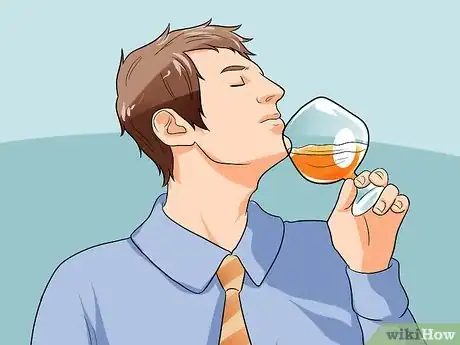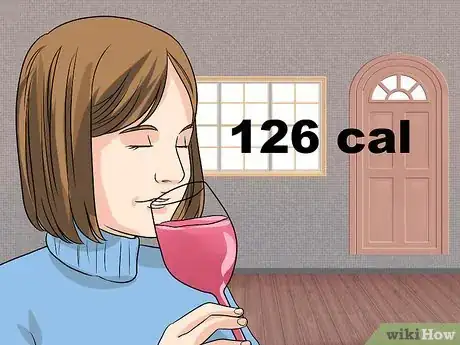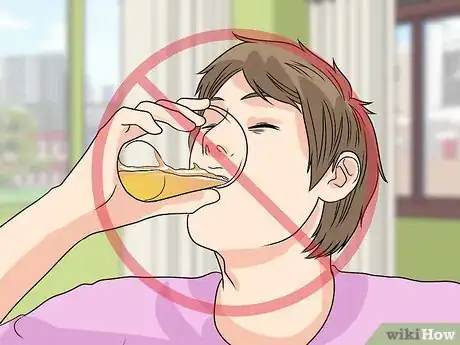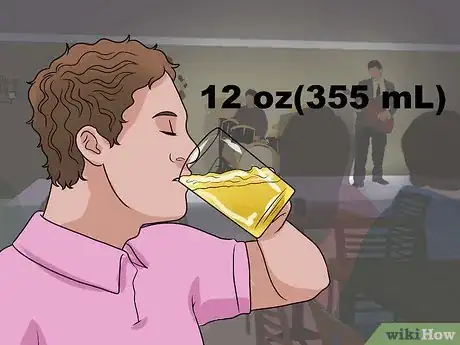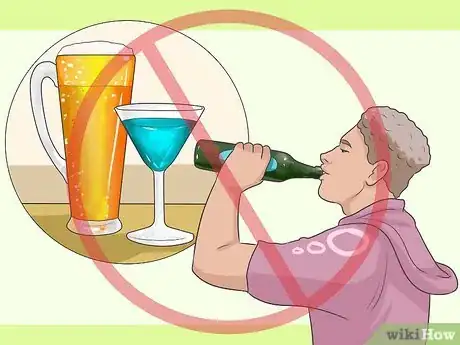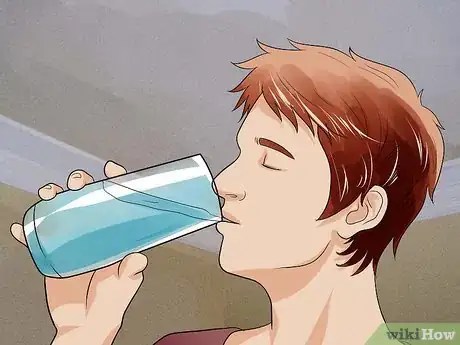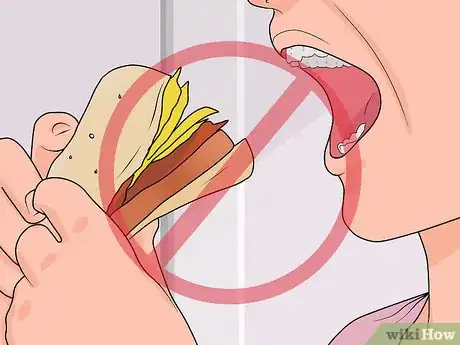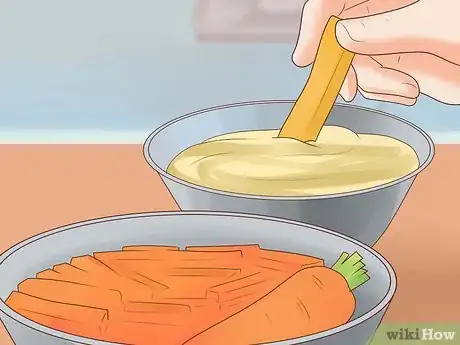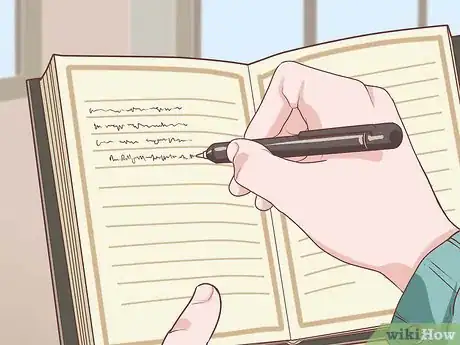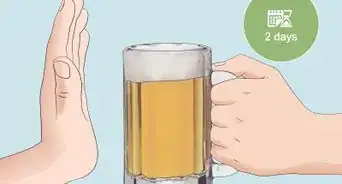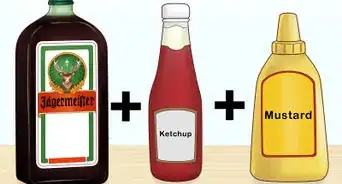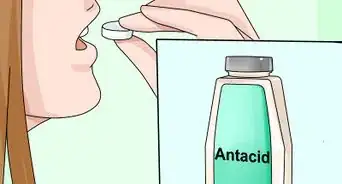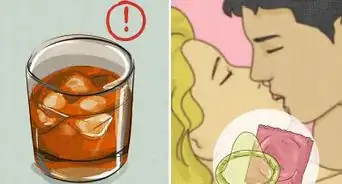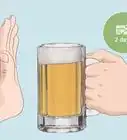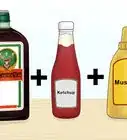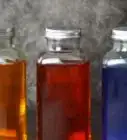This article was co-authored by wikiHow staff writer, Jennifer Mueller, JD. Jennifer Mueller is a wikiHow Content Creator. She specializes in reviewing, fact-checking, and evaluating wikiHow's content to ensure thoroughness and accuracy. Jennifer holds a JD from Indiana University Maurer School of Law in 2006.
This article has been viewed 22,571 times.
Learn more...
It's unlikely that you'll find alcoholic beverages recommended by any weight-loss diet. However, that doesn't mean you can't drink alcohol while you're on a diet. In fact, drinking in moderation can even give your weight-loss efforts a boost by raising your body temperature and slowing the growth of fat cells. All good news if you're tired of turning down invites to social occasions –as long as you maintain responsibility for your alcohol consumption, choose the right drinks, and control your eating while you're tying one on.[1]
Steps
Choosing Your Drinks
-
1Go for pure spirits. Pure spirits (also known as liquors) typically have fewer calories and carbs than any other alcoholic drinks, as well as less sugar. If you have the palate for neat whiskey or a scotch and soda, make something like that your go-to drink.[2]
- If you're on a low-carb diet, stick to whiskey, brandy or tequila – all of which have zero carbs.
- Whiskey, vodka, and rum each have only 64 calories per shot, compared with more than a hundred calories per serving of beer.[3]
- Spirits also have higher alcohol content per volume than beer or wine, which means that you'll drink far fewer calories.
-
2Watch your mixers. If you don't care for the taste of straight liquor, it's okay to have a mixed drink while you're on a diet. However, you need to pay attention to the drink's recipe so you know what goes into it, and avoid sugary mixers.[4]
- Serious cocktails such as Long Island Iced Teas not only have several shots of alcohol, but also pack a lot of sugar and calories. However, even a simple drink such as a rum and Coke can still derail your diet – not with the rum, but with the mixer.
- Even a drink such as a gin and tonic, which isn't really a sweet-tasting drink at all, carries 16 grams of sugar. One or two of those could potentially bury your diet.
- If you need to dilute the taste of the spirits with something, try cub soda, which has no sugar or calories.
- When making mixed drinks at home, avoid bottled, pre-made mixers, which typically are high in calories and sugar (although there are some "diet" versions available).
- The worst possible drinks – whether alone or mixed with something else – are cream-based liqueurs, such as Irish cream, along with other cream-based mixed drinks such as Amaretto Sours, or mudslides (which weigh in at 820 calories).[5]
Advertisement -
3Pick non-carbonated over carbonated beverages. Apart from typically having more calories and sugar, the alcohol in bubbly drinks is absorbed faster than in drinks without carbonation.[6]
- While faster absorption alone may not impact your diet directly, it can destroy your diet indirectly because the alcohol you drink will effect you more quickly. This means you could potentially feel a heavy buzz after one or two glasses of champagne, lowering your inhibitions and making you feel hungry – even if you just ate.
- Carbonated drinks also can cause bloating and fluid retention, which can lead to dehydration.[7] This is the reason you may have heard of the "beer belly" – drinking beer and other carbonated alcoholic beverages can result in greater fat deposits around your midsection.
-
4Favor red wine over white wine or champagne. Generally speaking, the sweeter a wine is, the worse it will be for your diet. While red wine is relatively low in calories and sugar, white wine can include significant amounts of sugar and carbohydrates.[8]
- Wine has antioxidants and other nutrients that actually can improve your health if drunk in moderation. After all, wine is made of fermented grapes, which in and of themselves can be a healthy diet snack.
- Choose a dry wine for fewer carbs. You typically can have a glass or two of dry red wine on a regular basis on even the strictest low-carb diet.[9]
-
5Avoid beer. Generally speaking, beer is your worst enemy if you're on a diet. It's carbonated, high in carbohydrates, and high in calories. If you drink a wheat beer, you're essentially drinking fermented liquid bread.[10]
- Many larger beer companies have introduced light and low-carb brews to their lineup, but you may not find these appealing – particularly if you love the taste of regular beer.
- If you are going to have a beer, go for a darker beer, such as a stout, which has about 170 calories per pint. Lighter beers average around 195 calories per pint, but can have even more.[11]
- The other advantage of darker beers is that they are heavier, and will make you feel more full. They also typically have a slightly higher alcohol content than lighter beers.
Monitoring Your Alcohol Consumption
-
1Limit yourself to two drinks. Getting drunk can negatively affect more than just your diet. Especially if you're out on the town, set yourself a hard limit of one, maybe two drinks – depending on how long you're out.[12]
- One drink a day is considered moderate drinking. If you only drink once or twice a drink, you probably can get away with having two drinks. But more than that, and you're at serious risk of blowing your diet.
- Generally speaking, one drink per hour is a good pace. However, this doesn't mean if you're out with your friends for four hours owning bar trivia, that means you can have four drinks. Even if you haven't had a drink all week, having more than two drinks in a night can seriously damage your health and put all the benefits you're getting from your diet at risk.
- Keep in mind that your diet is about your health, not your budget. Your limit doesn't mean "only two drinks unless someone else is paying." It means two drinks, period.
-
2Order fewer drinks at bars or restaurants. When you're counting your drinks, keep in mind that the drinks you get from a bar or restaurant typically will be larger – sometimes significantly larger – than the drink you would make at home.[13]
- Before you go out – or when making drinks at home – it's important to know what constitutes a "drink." You may have a 32-ounce stein, but filling it full of beer doesn't mean you've only had one beer.
- A "drink," for the purposes of measuring alcohol, is defined as one serving of alcohol. This translates to a 12-ounce bottle of beer, 5 ounces of wine, or a single shot of liquor. However, restaurants and bars may give you a pint of beer (that's 4 ounces over a single serving), or mixed drinks with multiple shots.
- Keep serving sizes – not drink sizes – in mind when you're ordering at a bar or restaurant. For example, if you've limited yourself to two drinks, and you order a double, that's your limit. Two shots of liquor is equal to two servings of alcohol.
-
3Alternate alcohol with water. With every alcoholic drink you consume, you should be drinking at least 12 ounces of water. If you're out at a bar or restaurant, order ice water along with your drink and take two sips of your water for every sip you have of your drink.
- You also should drink at least one big glass of water before you go out, or before you start drinking. Alcohol has a dehydrating effect, so you want to make sure you're well hydrated before you even start drinking, then maintain your hydration level by balancing your alcohol intake with water intake.
- When you get back home, have another big glass of water or two before you go to bed.
Watching What You Eat
-
1Have a healthy meal or snack before you go out. Munching on something with fiber, healthy fat, and protein will give you long-lasting energy that can counter alcohol's tendency to raise your blood sugar.[14]
- If you don't have a full meal, you should at least have a snack, such as Greek yogurt with berries, a handful of almonds, or an apple.
- Keep in mind that the alcohol in your drinks won't be absorbed as quickly if you drink on a full stomach. This can keep you from trashing your diet once a buzz kicks in.
- If you're going out for dinner, pull up the restaurant's menu online before you go out so you have time to study it and make a healthy choice that won't blow your diet.
-
2Stay away from the bar food. Once you have a few drinks, greasy fries, nachos, or mozzarella sticks might start sounding like just the thing you need. However, if you abandon your diet to that extent after a few drinks, you'll end up regretting it.[15]
- While greasy food can help settle the stomach a little if you've had one too many, you may pay for it in the morning – especially if you've maintained a healthy diet of whole foods for weeks or months. Your body isn't used to that kind of food, and may reject it.
- The other side of that is your body will end up storing as fat anything it doesn't recognize as food. If you go for greasy fried food after a night drinking, chances are most of it will end up around your midsection.
- Many bars also have plentiful snacks hanging around, such as peanuts or pretzels. Move them far enough away from you that they aren't within arm's length, or sit with your back to them.
- If you're out with friends and someone orders appetizers for the table, keep them out of your line of sight so you won't be tempted to take some.
-
3If drinking at home, keep healthy snacks close at hand. When you're drinking, you tend to get hungry. Keeping healthy snacks out if you're drinking at home means you'll be more inclined to reach for those than to start hunting for junk.[16]
- Almonds are a good go-to snack to have around, and you can just leave a bowl of them on the table.
- Edamame also can make a good snack with various alcoholic drinks – especially Japanese sake.
- If you tend to crave something salty when you drink, try organic tortilla chips with a simple avocado dip. You also can make a dip by mashing edamame.
-
4Plan your late-night snack ahead of time. If you're going out with friends, get your food together before you leave so that when you come home you'll have a healthy, filling snack ready to go and won't raid your fridge.[17]
- Before going to bed, choose a calming, high-fiber snack to get back some nutrients your body lost while you were out drinking. Hot cereal or oatmeal are good choices.
- Since foods with plenty of fiber take longer to digest, you won't go to bed hungry, nor will you wake up famished in the morning.
References
- ↑ http://www.prevention.com/eatclean/drinking-while-dieting
- ↑ https://www.dietdoctor.com/low-carb/alcohol
- ↑ http://www.bodybuilding.com/content/5-ways-alcohol-hinders-fat-loss.html
- ↑ http://www.health.com/health/article/0,,20670897,00.html
- ↑ http://www.bodybuilding.com/content/5-ways-alcohol-hinders-fat-loss.html
- ↑ http://www.bodybuilding.com/content/5-ways-alcohol-hinders-fat-loss.html
- ↑ http://www.mayoclinic.org/diseases-conditions/gas-and-gas-pains/in-depth/gas-and-gas-pains/art-20044739
- ↑ http://www.bodybuilding.com/content/5-ways-alcohol-hinders-fat-loss.html
- ↑ https://www.dietdoctor.com/low-carb/alcohol
- ↑ https://www.dietdoctor.com/low-carb/alcohol
- ↑ http://www.health.com/health/article/0,,20670897,00.html
- ↑ http://www.health.com/health/article/0,,20670897,00.html
- ↑ http://www.health.com/health/gallery/0,,20757335,00.html/view-all#count-your-drinks-correctly-0
- ↑ http://www.health.com/health/article/0,,20670897,00.html
- ↑ http://www.health.com/health/article/0,,20670897,00.html
- ↑ http://www.bodybuilding.com/content/5-ways-alcohol-hinders-fat-loss.html
- ↑ http://www.health.com/health/article/0,,20670897,00.html
